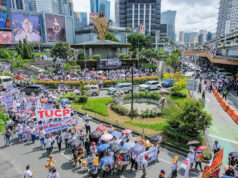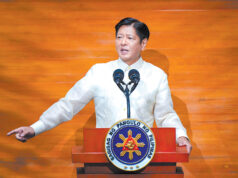Chinese envoy: PHL grants come with no strings attached
By Arjay L. Balinbin, Reporter
The Philippines is not a province of the People’s Republic of China, Chinese Ambassador to the Philippines Zhao Jianhua stressed on Tuesday, July 17, in response to the “Welcome to the Philippines, Province of China” banners that were hung from several pedestrian bridges in Metro Manila last week.
“It has never been any part of China. No, not now, not ever,” the Chinese official told reporters on the sidelines of the groundbreaking ceremony of the Chinese-funded Binondo-Intramuros Bridge and Estrella-Pantaleon Bridge projects in Intramuros, Manila, on Tuesday afternoon , which was also attended by President Rodrigo R. Duterte.
In his speech, Mr. Zhao promised that the Philippines will not fall into a “debt trap” as it funds major infrastructure projects under Mr. Duterte’s Build, Build, Build program.
“China’s grants do not have any strings attached to them, and China’s loans to finance infrastructure projects will not make the Philippines fall into a debt trap,” he said.
He added: “Because under the wise leadership of President Duterte and the economic management team headed by Finance (Secretary Carlos G.) Dominguez III, they are smart enough not to allow the Philippines fall into the so-called debt trap, and China will honor this commitment to make sure those projects will benefit the Filipino people and will not have any inactive impact on the socio-economic development of the Philippines.”
The Chinese official likewise said that China views the Philippines as one of the most important participants in its “belt and road initiative (BRI),” a development strategy by the Chinese government which focuses on connectivity and cooperation between Asia and Europe through infrastructure projects.
For his part, Mr. Duterte directed the Department of Public Works and Highways (DPWH) and other agencies concerned to ensure that the construction of the two bridges will be finished “within 30 months or earlier.”
The President said the Chinese-funded bridge projects “represent a desire to use connectivity and mobility as catalysts to inclusive economic growth and sustainable development.”
“These bridges will not only improve the capacity and the efficiency of Metro Manila’s transportation corridor by providing additional bridges and routes across Pasig River, but will also enhance the resilience of our road network against natural disasters. The life of these bridges will be extended because they would become more resilient, thereby reducing bridge maintenance costs. Moreover, it is also, it will also increase the transportation capacity of Pasig River and contribute to local tourism due to the improved view of the river area,” Mr. Duterte explained.
The two projects are among the 14 agreements signed during Chinese Premier Li Keqiang’s state visit to Manila in November last year. The exchange of letters on the said projects was signed by DPWH Secretary Mark A. Villar and International Trade Representative and Vice Minister of Commerce Fu Ziying.
The Philippines and China had also signed Memoranda of Understanding (MoUs) on jointly promoting the second basket of key infrastructure projects cooperation, industrial parks development cooperation, jointly promoting the Philippine National Railways South Long Hall project cooperation, development of project list for cooperation in production capacity and investment, provision of goods for addressing climate change, defense industry cooperation, intellectual property field cooperation, strengthening youth participation, and cooperation between the Bases Conversion and Development Authority and China Development Bank; and agreements (MoAs) on financing cooperation on Chico River Pump Irrigation Project and New Centennial Water Source-Kaliwa Dam Project, Republic of the Philippines 2017 Renminbi Bond Issuance, and economic and technical cooperation.
SOUTH CHINA SEA DISPUTE
Also during his speech, the President disclosed that the two states have decided to set aside their disagreements on the South China Sea issue as both countries are currently holding talks on joint development efforts.
“I’d just like to tell everybody that in all of these discussions, China did not ask any, even one square of real estate in this country. Its geopolitics position is something that is critical to China, the stand which we disagreed as we filed the arbitration case. But in the meantime that we are talking about a concerted effort of both countries to develop… is going on,” he said.
Last Monday evening, a Chinese surveillance, according to MarineTraffic, docked at a port in Davao City, the hometown of Mr. Duterte.
“All ships from countries with whom the Philippines maintains friendly ties, may dock at our ports. Chinese survey ships, just like US warships, may dock at our ports. Only those afflicted with Sinophobia (anti-Chinese sentiment) will find the routine incident objectionable,” Presidential Spokesperson Harry L. Roque, Jr. said in a phone message to reporters when sought for comment.
Former chief justice Hilario G. Davide, Jr., in his presentation titled “Charter Change, Chaining Our People to a Future of Tyranny, Injustice, Corruption, Poverty and Penury,” maintained that the Philippines is becoming a colony of China.
“If you recall in a gathering of Chinese businessmen on 19 February 2018, at the Manila Hotel, the President mentioned of the Philippines being a province of China. Presidential Spokesperson Harry L. Roque, Jr. tried to cushion the impact of the President’s statement by saying that was only a joke,” he said.
He also said that “First, almost twice weekly, our national broadsheets put in one or two full-page ads pictures of Chinese President Xi showcasing his programs and the progress of Chinese in its world leadership.”
“Two, it was reported that just recently on two occasions, a Chinese military plane landed in Davao City. Three, China has reclaimed parts of our West Philippine Sea. Four, the President has already visited China and met President Xi thrice. Five, the Palace mentioned China-Philippines co-ownership of the West Philippine Sea. Six, in one of the President’s visits to China, China provided a P3.8 billion assistance to the Philippines and the construction for free of two bridges across the Pasig River. Seven, a few days after the President’s trip to China, Chinese military aircrafts landed at our Panganiban reef in our West Philippine Sea,” Mr. Davide explained.



